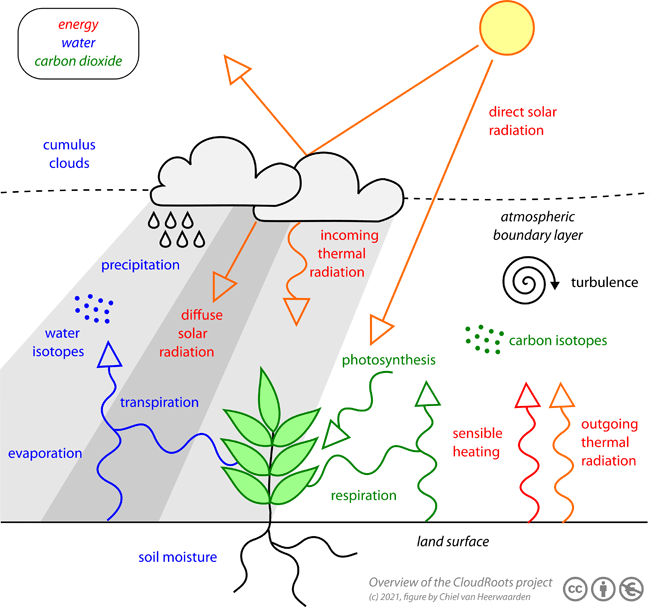DISCIPLINES
CloudRoots will develop an observation-simulation system with a specific focus on relationships between vegetation (BIOLOGY), the atmospheric composition and its transformation (CHEMISTRY) and the dynamics of clear and cloudy boundary layers (PHYSICS). Once this understanding is obtained, we will develop mathematical descriptions to represent these processes in weather and climate models. A key outcome of the CloudRoots findings is not only to study the present conditions of the land-atmosphere-cloud system, but also to investigate changes in plant and cloud behavior under future climate change conditions: enhanced CO2 levels, higher temperatures and an increase in the vapor pressure deficit.
The CloudRoots land-atmosphere-cloud system

PHYSICS
Physics is the third discipline investigated in CloudRoots. As the figure of DISCIPLINES shows, clouds perturb and control the amount of direct and diffuse radiation reaching the surface. The available energy is then partitioned into sensible heat flux, which is the main driver of atmospheric convective turbulence, and evapotranspiration, which is the main source of moisture needed to form and intensify clouds. Key aspects in this land-atmosphere-cloud system are the conditions in the free troposphere. These conditions are the lapse rate of temperature and moisture, and subsidence motions as well as the influence of large-scale advection. The combined and integrated experiments designed in CloudRoots will enable us to obtain enough observational evidence which will be used to design, constrain and evaluate the numerical experiments carried out by DALES and CLASS.
CHEMISTRY
Our main focus is to investigate the spatial evolution of the stable isotopes of carbon dioxide (12CO2, 13CO2 and C18OO) and water vapor (H216O, H218O). We plan to study whether the different fractionations between the heavy (13CO2 and C18OO, H218O) and light isotopologues (12CO2, H218O) provide a better quantification between soil, plant and atmospheric processes in the exchanges of water vapor and carbon dioxide under the presence of clouds.
In addition, we have the possibility to study the transformation of reactive species. More specifically, the chemical reactions associated with the NOx-O3-BVOC chain (NOx: nitrogen oxide, O3 ozone and BVOC biological volatile organic compounds) and the formation of secondary aerosol particles (SOC). These chemical mechanisms are incorporated into the two main modelling systems DALES and CLASS used in CloudRoots. These mechanisms offer the possibility to extend the study of the interactions in the land-atmosphere-cloud system to the formation of particles due to chemical transformations and how these transformations can influence the cloud microphysics and the subsequent cloud cycles.
BIOLOGY
As seen in the figure (FIGURE), the biological processes of leaves and soil are studied in CloudRoots. Driven by the amount of direct and diffuse radiation reaching the canopy, the leaves control the stomatal aperture and photosynthesis rate. We use mechanistic models to study the intermittency of light (sun or cloud flecks) and how they influence radiation, in-canopy temperature and water vapor deficit. Two photosynthesis pathways are included (C3/C4). A novel aspect of CloudRoots is to include the diurnal variability of water vapor and carbon dioxide stable isotopologues to study the individual contributions of soil and plants. The variability of soil moisture and temperature is also taken into account in representing the exchange of soil carbon dioxide (heterotrophic) and soil evaporation and their response to soil moisture stress (droughts).
READ MORE
